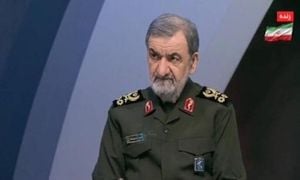President Donald Trump's return to the White House is poised to usher significant changes to the dynamics of U.S.-India-China relations, especially as Prime Minister Narendra Modi prepares for his visit to the U.S. early this month. The meeting is anticipated to solidify existing ties between the two countries, which have seen substantial growth amid fluctuated geopolitical tensions.
During the initial days of Trump’s new administration, the focus has already shifted toward aggressive foreign policy initiatives, particularly concerning the U.S. stance on China. Trump’s administration appears ready to adopt hawkish policies aimed at China, characterized by tariff threats and strategic defense partnerships. Reports suggest this could lead to increased challenges for Taiwan, as the U.S. investigates its trade deficits and threatens tariffs on products such as chips and semiconductors, primarily manufactured by Taiwan’s TSMC.
The backdrop to these developments is the economic relationship between India and the U.S., which has strengthened over the years. India reports a trade surplus with the U.S., but Trump’s inclination toward reciprocal trade poses potential challenges. Union Commerce Minister Piyush Goyal reassured earlier statements, emphasizing the strong bond of friendship shared between Modi and Trump. He stated, "President Trump and PM Modi share a very strong bond of friendship, and I am confident things will only get even more solid after Modi’s visit." This visit is significant as it marks the first bilateral meeting between Trump and Modi since Trump assumed office again.
Goyal's optimistic outlook on U.S.-India relations also encompasses collaborative efforts on tariffs. Specific points of contention, including immigration and defense procurement, linger as Modi prepares to engage with Trump during the February talks. With 75% of H-1B visas awarded to Indian professionals, any drastic immigration reforms could create challenges for India's technology sector, where approximately 200,000 Indian students are currently pursuing education.
On the defense front, the U.S. intends to push India toward greater procurement of American-made military equipment, particularly against the backdrop of the Quad alliance involving the U.S., India, Japan, and Australia. This arrangement is increasingly pivotal as regional tactics are reassessed amid China’s growing influence and recent diplomatic outreach efforts with India.
China’s response to Trump’s return is complex, and there is visible unease about Trump's unilateralist approach. Analysts have highlighted the possibility of Trump's approach leading China to strengthen its relationships with nations like Japan and India. Wu Xinbo, dean of the Institute of International Studies at Fudan University, articulated this sentiment by stating, "It is possible Trump may drift away from US allies, making them pay more attention to China's role." It's evident the outcomes of Modi's engagement with Trump could redefine this competitive dynamic.
Modi's planned conversation with Trump is also intended to address the array of regional challenges, particularly focusing on security concerns within the Indo-Pacific. The White House indicated the two leaders would discuss deepening cooperation and strategies for mutual economic benefits. According to sources, the administration is primed to build on the historical ties between the two nations, reiteratively emphasizing mutual benefits at the core of trade discussions.
The upcoming visit is not without its risks; Trump’s unpredictable foreign policy could unfurl nuances yet to be revealed during the leaders' dialogue. Past tariff threats against nations and the global natural gas strategy highlight the precarious balance India seeks to maintain between collaborating with the U.S. and engaging constructively with China.
Despite the turbulence, the Indian government seems secure in the strategic partnership. Goyal continues to express confidence, stating, "The current round of tariffs is not targeted against India. Every subsequent engagement has only strengthened the strategic and comprehensive partnership between our two countries." This optimistic perspective is reflective of India's broader aspirations to expand its influence alongside American cooperation.
On the regional level, other nations watch with bated breath as U.S.-China diplomatic relations enter yet another phase of recalibration. The Quad Alliance will remain pivotal as each member reassesses its collective strategies, amid Trump’s potential tariff wars and possible retaliatory moves from China.
India's roadmap forward is containing balancing acts: maintaining sovereignty over its border disputes with China, leveraging its strategic importance with the U.S., and managing the fallout from Trump's aggressive trade policies. While challenges undeniably loom, the fortification of U.S.-India relations remains central to countering Chinese aspirations.
All told, Trump's presidency is set to transform the geopolitical map of the Indo-Pacific, with Modi’s active engagement likely solidifying India's pivotal role as the U.S. navigates its approach to China. The actions taken and commitments made during Modi’s imminent visit will surely shape the nature of these trilateral interactions long-term.



